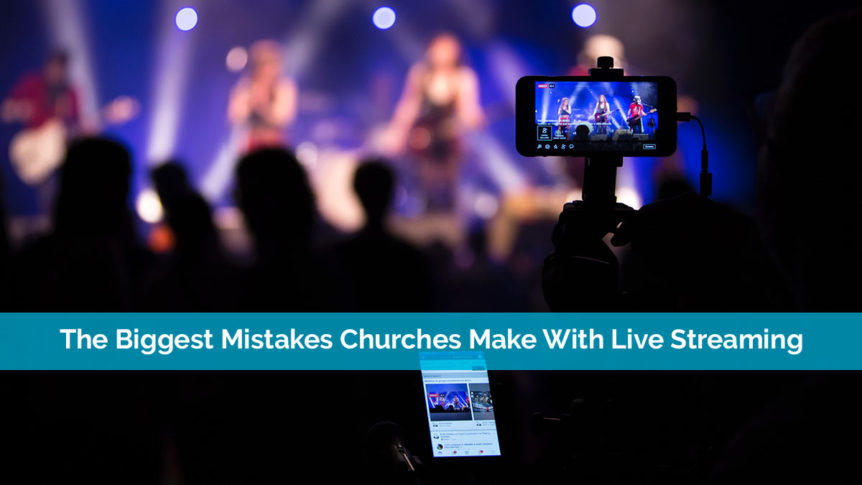Live streaming is the perfect way for your church to reach a much larger audience. It’s also ideal for engaging members who can’t always make it to weekly services.
Of course, if you’re trying to attract new visitors, letting them experience your services online before attending is a good way to help them see if your church is the right fit.
While all the benefits might sound great, it’ll only work if you do it right. By avoiding common mistakes, you’ll make live streaming even better for your church and your viewers.
Using Low-Quality Audio
Much like within your church, if no one can hear you, your words won’t make an impact. No matter whether you’re live streaming your services, special events or just Q&A sessions, viewers need to be able to clearly hear what you’re saying.

This often happens when microphones aren’t set up correctly or you’re just using the microphone on the camera or phone. Instead of clear audio, viewers hear muffled words, a lot of background noise and the occasional loud word or phrase. It’s not a pleasant experience for the viewers at all and odds are, they won’t come back for another session.
Ideally, invest in at least a basic microphone or headset with mic to ensure it’s easy to hear you. Test out the audio quality ahead of your live stream to make sure everything sounds right.
Using A Low-Quality Camera
Even if your church’s audio sounds amazing, you’re live streaming more than just audio. Otherwise, you just have an audio track. You need a high enough quality camera so your viewers can see what’s going on.
While you don’t need the highest quality camera ever, the video shouldn’t be blurry, staticky, grainy, too dark or too bright. Think about the videos you like to watch on YouTube. Poor video quality leads to a bad experience just as much as terrible audio.
Plus, viewers could easily get a headache trying to figure out what’s going on. The worst part is viewer focus so much on deciphering the video that they miss the message.
The good news is you can use something as simple as a higher-end smartphone. This works well for basic live streaming and is ideal for smaller churches with a limited budget. Over time, you may want to consider a more professional style camera that’s easier to work with.
Not Stabilizing Your Camera
Once you’ve got the audio and video quality sorted out, it’s time to talk about the camera stability. Keep in mind that at least some of your viewers and even members probably struggle with motion sickness. A camera that’s constantly moving around is going to make them too nauseous to watch.
Even if motion sickness isn’t a problem, wobbly cameras cause you to miss part of what’s going on and may even cause severe headaches for your viewers. The solution is to stabilize your camera.
Tripods are inexpensive and usually work with a wide variety of cameras. From camcorders and DSLR cameras to smartphones, a tripod keeps your camera steady. You should also consider picking a camera with image stabilization.
Use a tripod that allows you to smoothly move the camera from side to side and up and down. This allows you to view different angles during the live stream without looking like your church is going through a major earthquake.
Skipping Testing The Stream
The absolute worst live streaming mistake your church can make is not testing out the stream ahead of time. Testing allows you to avoid all three of the mistakes above and ensure your church is capable of streaming.
The last thing you want is to hype your first live stream only to have it go terribly wrong. A few things that could happen include:
- Choppy video from a poor Internet connection
- Issues working with your streaming platform
- Audio playing, but not video and vice versa
- No way to receive feedback (chat features don’t work)
- Viewers can’t access the feed
- The video is too high quality for viewers to access

It’s easy to test your live stream without just going live. Host a private viewing party with a handful of members. Only those who have the link can view it. You can even password protect the stream to avoid anyone stumbling upon it. Do this as often as necessary until you work out the kinks.
Investing Way Too Much On Equipment
Obviously, you want your church’s live stream to be the best possible. However, you don’t have to destroy your church’s budget to do it. Paying $5,000 for a camera, another $1,000 for lighting, and thousands more other equipment is ridiculous for a small church. If you have the budget for it, you can spend more. Otherwise, keep it simple.
Your highest expenses are your streaming service and your camera. However, you shouldn’t spend more than $100 a month or so for both of those combined. The camera is only a temporary expense until it’s paid off, but should still be an affordable piece of equipment for your church.
We’ve prepared a guide to sermon streaming companies to help you pick an affordable streaming partner. These are great options if you’re not streaming directly through your web host or Facebook. They also work as great additions to both of those options.
Keeping The Area Too Dark
One expense churches often neglect or spend too much on is the lighting. Live streaming requires good lighting to work well. However, if it’s too bright, everyone looks more like a neon ghost.
As long as the area is well-lit with overhead lighting, you’re fine. This is yet another reason to test before going live. Even if the area looks good to you, it may not look great through a camera lens. Try out various lighting and camera positions to figure out what works best for your church.
Avoiding Practicing Before Streaming
You might think we’ve already covered this, but practicing is different than testing. Pastors, choirs and guest speakers might be fine with church members. However, stepping in front of a camera, especially live, is a completely different story.
There’s a reason why pastors should start prepping their Sunday sermons on Mondays. It gives them ample time to fine-tune and practice. Of course, rehearsing is just a good practice to have.
Trying to wing it or just going over everything mentally isn’t going to work. Taking time to practice out loud helps you work out any issues well ahead of go time. You should even practice in front of a camera and check out the results.
The more you rehearse, the more confident you’ll be. You’ll speak, or sing, more clearly and not even think twice about the camera. This gets your message across better and engages your audience, both in-house and online, more effectively.
Not Defining A Clear Goal
Live streaming without a clear goal makes it difficult to cater the stream to your audience. For instance, if you’re trying to establish a bigger online community, you’d want to focus your sermons on topics that are applicable to more than just your members.
If you’re trying to grow your church, you’d want to stream more than just your sermons. You’d want to include major events, volunteer sessions, the occasional ministry group meeting and even live Bible study sessions. All of these work to give potential new members a well-rounded view of your church and how they can get involved.

If you’re mainly live streaming for your members, you’d be fine just streaming your sermons. This is what most members would want to view as they couldn’t attend regular services in person for whatever personal reason, such as an illness.
Having No Way To Measure Results
While some people actually think live streaming hurts church attendance, it can actually boost it if you’re not making common mistakes. However, you should always make sure it’s benefiting your church the way you planned.
Always have ways to measure the results. A few things you may want to measure include:
- New visitors/members
- Member retention rate
- Attendance rates
- Number of online viewers
- Engagement among online viewers, such as comments, questions, etc. (this only applies if you allow viewers to interact)
- Feedback from members (send out surveys)
- Tithing amounts
- Social media engagement (even if you’re not streaming on social media)
- Website visits
All of these numbers help you to see the effects of live streaming on your church. If you’re not seeing any positive benefits, then it may not be working in your church’s favor. However, give it at least a few months. Make sure you’re promoting it on your church’s website, social media channels and by word of mouth with your members.
Don’t be afraid to ask for feedback and work to improve each live stream. By making tweaks, you could easily go from a failed attempt to a highly successful stream.
Excluding Online Viewers
You’re used to only trying to engage your members, so don’t feel bad if you’re making this live streaming mistake. However, you have a second audience to think about now. Make eye contact with the camera. Talk to that audience too.
If you’re making announcements, have a few that are just for your online audience. For example, remind them to follow you on social media for weekly suggested reading and to discuss it with fellow Christians.
Invite online viewers to attend in person or to come back for your next live stream. Thank them for their time just like you do your members.
Only Streaming In One Place
Do you only stream in one place? For instance, do you only stream on your website or just Facebook? If possible, try to live stream in a few places at once. This makes it more easily accessible for everyone.
At the very least, make sure viewers won’t need any extra software or apps to stream. The easier it is for them to access the stream, the more people who’ll want to stream it.
Not Listening To Online Viewers’ Needs
Give your online viewers a voice. Ask them what they want and need. Are your sermons helping them enough? Could they use a little more interaction during the week?

The best way to improve your streaming is to listen to your online viewers. They’re happy to provide feedback on everything from video quality to sermon topics. Odds are if your online viewers have feedback, your members probably have similar feedback. Just remember, don’t try to please everyone.
One thing your online audience may want and need is different streaming qualities. Offer several different bitrates so people on slower connections are able to stream too.
Not Considering Licensing
While most places won’t target churches, you could be violating copyrights by not getting the proper licensing and permission to use certain songs, videos and images. Even if you have the rights to use them within your church, you may not have the same rights to use them online or within videos.
Check all copyrights and licensing on any background images in your streams, any videos you might play during the stream and any music you play or sing. It’ll save you quite the headache in case someone does complain.
Not Putting Your Church Family’s Privacy First
Your church might be excited about live streaming, but what about your members? Remember, they’re part of your church family and deserve the right to exclude themselves from being viewed online.
This is especially true for parents. They might not want their kids’ faces being viewed by strangers online. It’s important to respect everyone’s privacy. You can still live stream, but ensure your camera is angled to avoid showing anyone who doesn’t want to be seen.
Not Preparing A Backup Plan
Out of all the live streaming mistakes churches make, this one might not seem as important. However, what happens if your camera person suddenly gets sick an hour before you go live? Who will control the camera and do they know how?
Always have a backup plan in place in case something goes wrong. You may have secondary equipment (let the audience know in advance if it’s a different quality), additional volunteers and a note to post if there’s a delay.
Want to start live streaming your church services? Start with our ultimate guide. And then, make sure your church’s site is easy for your online audience to find with our free website analysis.





Comments 3
What do I need to Livestream my first missionary trip to Kenya in Dec.
Author
we have a whole post about how to do a livestream: The Ultimate Guide To Live Streaming Your Church Services
I guess you made a pretty good point that churches who are live streaming must invest in high-quality cameras so the viewers will see everything. Well, we also share the same opinion that it would be best to use a tripod. Anyhow, if I were them, I would probably hire a live streaming service since the former is equipped with the right tools and equipment.